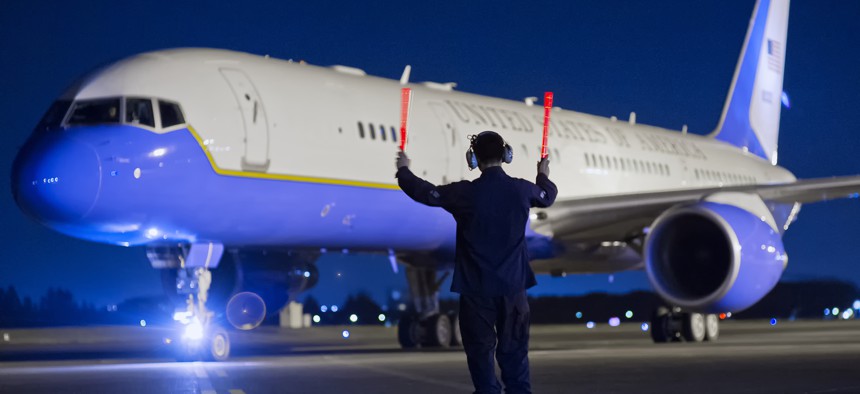
A C-32 aircraft taxis at Yokota Air Base, Japan, in 2011. U.S. Air Force / Osakabe Yasuo
Pentagon Wants to Get Started on New Air Force Two and Doomsday Planes
The aging C-32 and E-4B may be replaced by similar aircraft, or at least with planes that share some gear.
After President Trump lashed out at the nascent effort to buy a new Air Force One, the Pentagon might be forgiven for soft-pedaling the launch of its effort to replace the four Boeing jetliners that serve as Air Force Two.
Tucked inside the Trump administration’s first federal budget request is $6 million to create a project office and start studies to determine what will replace the Air Force’s C-32As, the modified Boeing 757s that generally fly the vice president, other top-ranking cabinet officials, and members of Congress.
The plane is also occasionally used by the president to travel to airports whose smaller runways cannot handle the VC-25A, the Boeing 747 that usually bears the Air Force One callsign.
“The C-32A recap aircraft would be a more robust aircraft that would mitigate many capability gaps that exist when the current C-32A aircraft serve as a backup to VC-25A and [the new Air Force One],” the Air Force said in its budget request. “The C-32A replacement aircraft would have increased range, passenger capacity, enhanced senior leader communications and a private work space.”
The Pentagon wants to “better align” the new Air Force Two with its new Air Force One and another project to replace the E-4B, the so-called “Doomsday Plane,” a flying operations center that could be used by the president and defense secretary in a nuclear war. The defense secretary routinely flies on the E-4B when he travels overseas.
As well, Trump’s Pentagon budget also includes a $7.8 million request to begin work to merge the missions of the E-4B and Navy E-6 Mercury — another nuclear command plane — into a “uniformly-configured aircraft.” That new plane would be called the Survivable Airborne Operations Center.
Related: Buying a New Air Force One Is Complicated
Related: Trump’s Air Force One Tweet Rattles the Defense Industry
Related: Boeing Breaks Air Force One
The Doomsday Plane has been flying since 1980 and the E-6 has been around since the early 1990s.
The Air Force has not said what plane it will buy, other than a “commercial derivative aircraft” — that is, a jetliner already in production. That rules out the 757. The most likely American-made C-32 replacement candidate is the Boeing 767, which the Air Force is buying for new tanker planes. While it is slightly longer than the 757, the 767 is a widebody aircraft, meaning it can carry more people and gear.
The C-32s have had their share of maintenance woes. In 2014, one broke down in Hawaii before the final flight of a nine-day trip to the Pacific by then-Secretary of State John Kerry. Two months later, his plane broke down in Vienna. Both times Kerry had to fly back to Washington commercially. In all, Kerry’s plane broke four times in 2014.
Boeing delivered all four C-32s to the Air Force in 1998, according to company data. The final 757 was delivered to Shanghai Airlines in April 2005. Since it’s been out of production for more than a decade, and fewer and fewer airlines operate the plane, getting parts for the jetliner becomes more difficult every year. In March 2016, the Air Force gave Boeing a $319 million contract to overhaul the C-32 and its smaller sibling — the C-40, the military version of the 737 — through 2023.
Aside from the glossy white-top-and-blue-belly paint jobs, the Air Force jets came with satellite communications and other high-tech gear. Inside, the plane is sectioned off into different cabins. The front section hosts crew workstations, a small private room with a couch and desk is in the middle, staff work areas behind that and more staff and flight attendant seats are in the back. While comfortable, the plane is not luxurious, a far cry from newer commercial airliners with lay-flat seats and private quarters.




